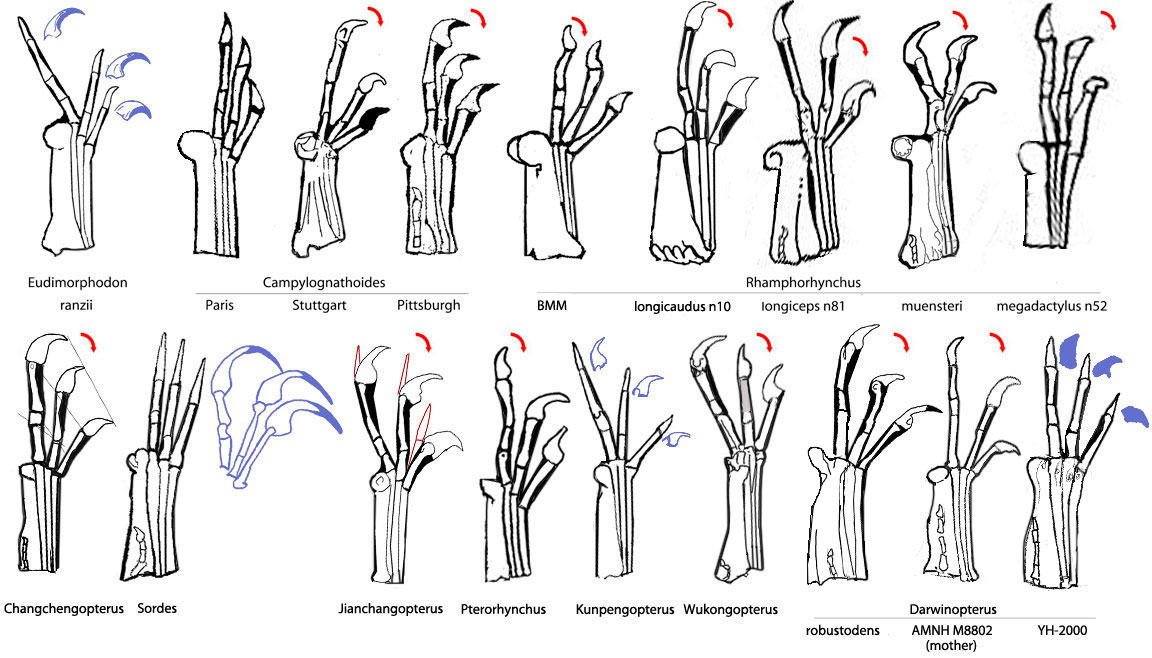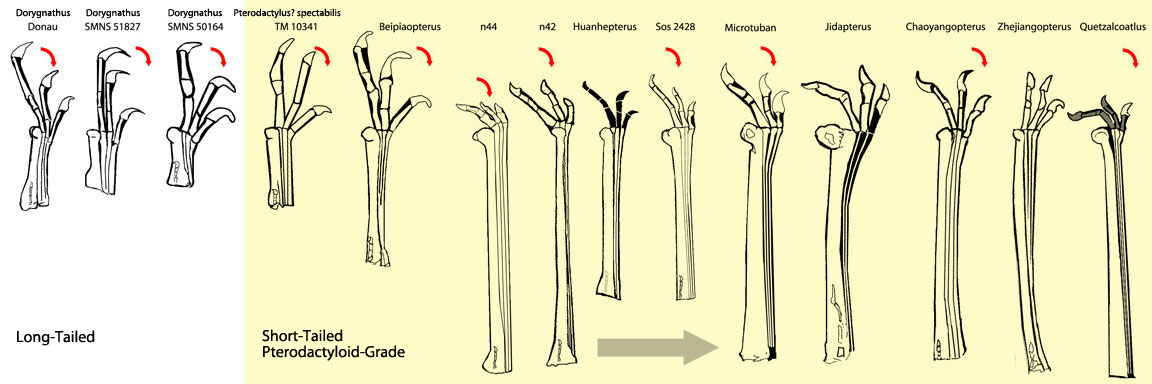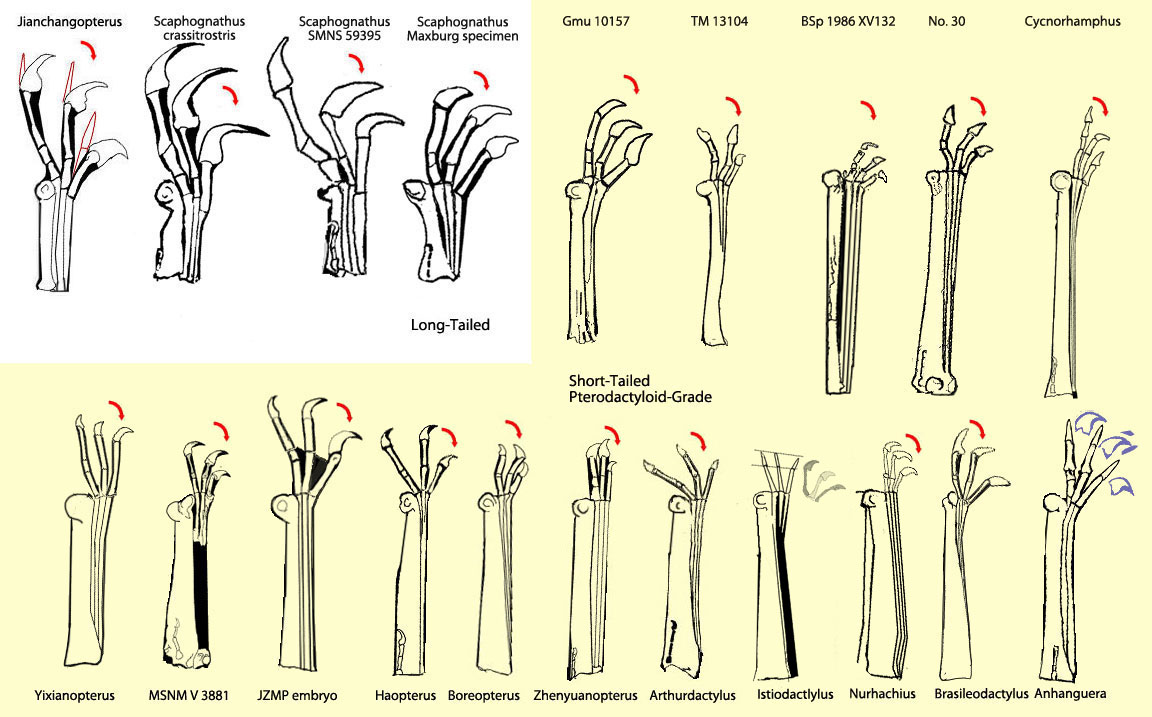| Pterosaur Fingers - Basal Taxa and Dimorphodontids
MPUM 6009 - The manus of the most primitive pterosaur MPUM 6009 was relatively smaller than that of its phylogenetic predecessor, Longisquama and distinct in terms of metacarpal and phalanx proportions. In MPUM 6009 metacarpal 1 was ~60% the length of metacarpal 3, which was just shorter than metacarpal 4. Metacarpal 3 was more than half the diameter of metacarpal 4. Manual 1.1 was twice the length of m2.1. Digits 1 and 2 were subequal and shorter than digit 3.
Austriadactylus and SC 332466 - In both of the pterosaurs attributed to Austriadactylus metacarpal 1 was relatively longer. Metacarpal 3 was more gracile and as long as metacarpal 4. Manual 1.1 was relatively smaller. Digit 2 was longer than digit 1.
GLGMV-0002 - The basal dimorphodontid GLGMV-0002 had a more robust metacarpal 4. Manual 3.2 was shorter. Digit 3 was relatively shorter and shorter than metacarpals 3 and 4.
Dimorphodon macronyx - The metacarpals were all relatively shorter and digit 3 was longer creating more asymmetry in relative finger length in Dimorphodon micronyx.
Preondactylus - The phalanges of digit 3 were more similar in length in Preondactylus.
Peteinosaurus - Metacarpal 4 was more gracile as were the fingers and unguals in Peteinosaurus. Digit 3 was 50% longer than digit 2.
MCSNB 8950 - Longer metacarpals appear in MCSNB 8950. Manual 2.1 was longer. Manual 3.2 was shorter.
IVPP embryo - The IVPP embryo comes form the Early Cretaceous and thus represents a late-surviving representative of a Late Triassic/Early Jurassic radiation. Metacarpal 4 was longer and more robust, and wider than mc1-3 combined. Metacarpals 1-3 were more gracile and essentially subequal in length. Digits 1-3 were more gracile and relatively shorter and shorter than the metacarpus. The penultimate phalanges were subequal.
Dimorphodon? weintraubi - Metacarpal 4 was not much more robust than mc1-3 in D? weintraubi. While mc1 remained slightly shorter than mc3, all three metacarpals were aligned. The digits were longer than the metacarpus. The digits were less asymmetric. Manual 3.2 was no longer than wide.
Anurognathids
Dendrorhynchoides - Metacarpals 1-3 remained robust and subequal in Dendrorhynchoides. Digits 2 and 3 were subequal. Manual 2.1 and m 3.1 were subequal and short.
Flathead anurognathid (SMNS 81928) - Here metacarpals 1-3 were aligned, but mc1 was the longest in the set. Manual 2.1 was as long as m3.1+m3.2 and aligned with m1.1. Manual 3.3 was longer than m2.2. Digits 2 and 3 were nearly subequal. Manual 2.1 was subequal to m3.1+m3.2.
Anurognathus ammoni - Metacarpal 4 was more robust and shorter such that the pulley joint was half the length of metacarpal 4 in Anurognathus ammoni. Metacarpal 4 was slightly shorter than mc1-3, which were subequal to each other. Manual 2.1 was half as long as m3.1. Manual 2.2 was subequal to m3.3. The unguals were nearly as long as the penultimate phalanges.
CAGS IG 02-81 - Manual 2.1 was subequal to m3.1 in this pterosaur attributed to Jeholopeterus. Metacarpal 4 was not so robust, similar to mc 1-3. Manual 3.2 was shorter than wide.
Jeholopterus - The metacarpus in the holotype of Jeholopterus was relatively longer than in the CAGS specimen. Metacarpal 3 was the shortest. Metacarpal 1 was subequal to mc4. Digit 2 was slightly longer than digit 3. Distinct from other anurognathids and other pterosaurs, the unguals were narrow, strongly curved and elongated like surgical needles. This trait, among others, led to the hypothesis of vampirism in this taxon.
Batrachognathus - Metacarpal 4 was short and very robust in Batrachognathus with a broader base than in Anurognathus. Metacarpals 1-3 were shorter than mc4. Digits 1-3 were subequal. Manual 3.2 was a disc. Manual 1.1 was longer than m3.2 and m4.3. The unguals were shorter than in Jeholopterus. |






